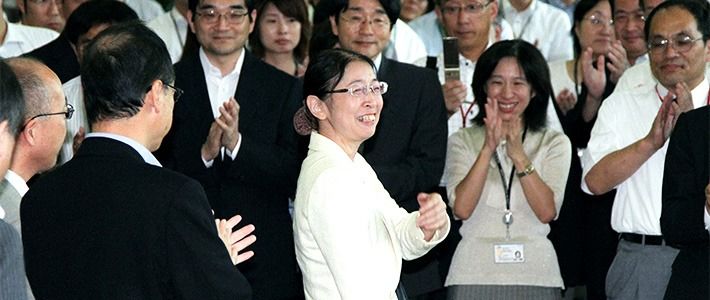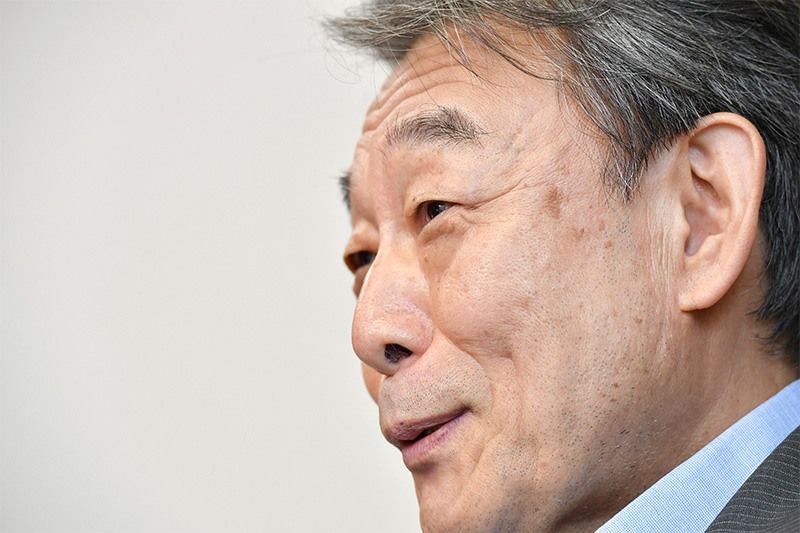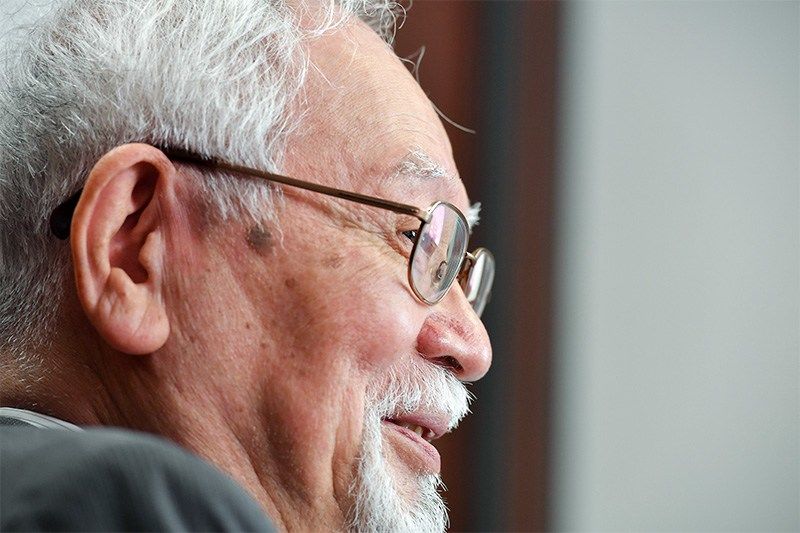
Harsh Judgment: Japan’s Criminal Justice System
Citizens on the Bench: Assessing Japan’s Lay Judge System
Society- English
- 日本語
- 简体字
- 繁體字
- Français
- Español
- العربية
- Русский
The Fruits of Compromise
INTERVIEWER The lay judge system, Japan’s version of civil jurors, was introduced in May 2009 in the hope of speeding up trials and increasing public understanding of the legal system. After a decade, how do you assess the system?
MURAI TOSHIKUNI Like many legal experts I feel the lay judge system is still a work in process and that many issues remain to be addressed, but overall I support it. Legal professionals may know how to interpret the law, but this doesn’t mean they are any better at determining the facts of a case than the average citizens. In fact, the legal system benefits from having diverse people involved.
It should be kept in mind, though, that the lay judge system was imperfect from the start. Japan tried adopting a jury system in the prewar era, but the arrangement was so flawed that it was scrapped when the legal system was revamped after World War II. Subsequently, many legal scholars and even some judges called for its return, arguing that Japan’s 99.9 percent conviction rate in criminal trials indicated that the scales of justice were far out of balance.
Hirano Ryūichi, a legal expert and president of the University of Tokyo, was one leading advocate. In 1985 he penned a paper arguing that juries or lay judges were necessary to remedy the serious flaws he saw in Japan’s criminal justice system. He was actually critical of both approaches, but the weight of his opinion strengthened support for bringing back the jury system. In the end, though, authorities compromised and adopted a lay assessor system consisting of a panel of citizen judges who rule in cases alongside professional judges.
Citizen Participation in Criminal Trials
| Lay Assessor System | Juror System | Lay Judge System | |
|---|---|---|---|
| Country | Japan | Britain, USA | France, Germany |
| Participation | Jointly with judge | Jurors only | Jointly with judge |
| Involved in verdict | Yes | Yes | Yes |
| Involved in sentencing | Yes | No | Yes |
| Term | Individual cases | Individual cases | Set term |
| Selection | At random | At random | Recommended or appointed |
Created by Power News based on Japanese Supreme Court data.
Verdicts Slow to Come in Capital Punishment Cases
MURAOKA KEIICHI Lawyers strongly supported the jury system, and when the Cabinet Office formed the Judicial Reform Council in 1999 to review the justice system, citizen participation emerged as a major theme. Council members debated the pros and cons of both the jury and joint judge-jury systems. In the end they decided on a lay assessor system that combined positive aspects of both approaches.
I was initially in favor of jury trials from the standpoint that ordinary citizens should be given a voice in the judicial system. However, I’ve developed some grave concerns about how the system is actually functioning. One alarming statistic is that rulings in favor of capital punishment are around 20 percent higher with lay assessors than with professional judges. Many experts argue that this reflects broad public support for the death penalty, but I seriously question this interpretation.
The pretrial process was revamped to speed up court cases, but there are generally more points to iron out than can be covered in the time allowed. As a result, lay assessors frequently aren’t able to thoroughly review the relevant evidence needed to make an informed decision on whether capital punishment is justified. The increase in death-penalty rulings has nothing to do with public support, but stems from an overemphasis on speeding up the trial process. The scale of the problem has nearly made me an outright opponent of the lay assessor system.
MURAI I remain in favor of the system, but there is undoubtedly room for improvement. The first step would be to do away with the death penalty entirely. The difficulty of choosing lay assessors only increases in capital punishment cases, which are inherently slow owing to the gravity of the punishment. It’s unjust to introduce measures to hasten trials, as this will keep many vital aspects of a case from receiving the full consideration they require.
Lay assessors in capital punishment cases typically only consider compelling aspects of a case like the severity of the crime and number of people killed. They don’t take into account factors like the motive or personal history of a suspect, and subsequently higher courts sometimes overturn sentences that are deemed too harsh. The lack of a clear and fair standard for applying the death penalty is a major fault of the lay assessor system.
The Problem of Low Participation Rates
MURAOKA Judges must be certain that a sentence fits the crime, particularly in the case of capital punishment. Sentencing under the lay assessor system, though, doesn’t give this impression at all. I’m certain that assessors would choose the death penalty less frequently if they had more evidence to review and more time to deliberate the facts.
MURAI In fact, many lay assessors say that they needed more time to consider cases. The shorter trial periods are meant to reduce the burden on citizen judges, but having a time limit loom over the entire proceedings further complicates the already onerous task of deciding whether a person should pay for a crime with his or her life.
MURAOKA Another serious issue is the high frequency of people requesting to be excused from serving as lay assessors. Those citizens who are called are extremely capable, but the fact that over 60 percent of potential jurors decline to serve makes it questionable whether the goal of promoting public engagement in the criminal justice system is being met.
Aversion to Recording Police Interrogations
INTERVIEWER Video recording interrogations in cases involving lay assessors will be mandatory starting in June 2019. The measure has been lauded as a means of preventing law enforcement authorities from employing coercive techniques during questioning to force a defendant to confess. The police have been recording interrogations to some extent for the last decade, so what do you see as the impetus and effectiveness of the measure?
MURAOKA Videoing interrogations adds transparency with the aim of reducing reliance on documental evidence and making it easier to prove the credibility of a defendant’s confession. It has been successful in this regard and in eliminating the use of strong-arm tactics during questioning.
However, my concern from the start was that interrogation videos would influence judgements, and this has turned out to be the case. Lay assessors and judges tend to put more weight in videos when making their decision compared to more relevant evidence and facts.
MURAI I agree that the current guidelines increase the risk that video evidence will overinfluence the decisions of lay assessors. Suspects should really be questioned in the presence of their lawyers and the footage should be reviewed to determine what parts are pertinent to a case. Otherwise, just submitting a video as evidence raises the likelihood that lay assessors will base their judgements on the recordings without giving proper consideration to more relevant evidence, such as a defendant’s confession.
MURAOKA The police and prosecutors were initially against videoing, but came to favor the approach once they realized recording could be used as evidence to bolster cases. Of course, defense lawyers have long argued for greater transparency, and were behind the measure from the start. Since videos have effectively become a form of evidence, they are now pressing to be allowed into interrogation sessions.
No Safeguards Against False Charges
INTERVIEWER Along with greater transparency, the 2016 amendments to Japan’s criminal procedure law also introduced plea bargaining. Although the measure is largely framed as a way to entice members of organized crime syndicates to cooperate with prosecutors, some experts have raised concerns that false statements by suspects looking to get their charges reduced could lead to people being wrongfully accused.
MURAOKA Plea bargaining is a powerful tool for getting at accomplices and criminals higher up the chain, but there needs to be measures to prevent innocent people from being the target of false accusations. However, Japan’s plea-bargaining system lacks such reliable safeguards.
MURAI Japan has not traditionally allowed plea bargaining and I’m skeptical about its introduction. The Supreme Court previously ruled that negotiating concessions from criminal responsibility was unconstitutional, saying it was not in line with Japanese legal culture. Prosecutors have also pointed to Japan not having such a system as proof of the fairness of Japanese law.
The Role of the Defense is Not to Bargain
MURAOKA The American plea-bargaining system safeguards against false accusations by assuring that all the evidence in a case is open for review and allowing for court participation in agreements. In Japan, though, the prosecutor cuts a deal directly with the suspect. The defense attorney scrutinizes the agreement, but this still leaves the door open for false charges to be brought against an innocent person.
The primary role of the defense is to defend a client, but plea bargains can undercut this relationship. A defense attorney has little recourse but to go along if the client chooses to cooperate with the prosecution. However, by representing a suspect who has turned state’s evidence, defenders are in effect forced to provide evidence in the prosecution’s case against a third party.
I firmly believe that the defense should always be in opposition to the prosecution and never be forced to support the state’s investigation against another party. However, the fact that the Japanese plea-bargain system does not require prosecutors to share the entire scope of evidence they have compiled and that the court does not play a role in deals makes this unavoidable in certain circumstances.
MURAI I completely agree that the entire setup is extremely unfair. The lawyer representing a person fingered as part of a plea deal is completely in the dark about the agreement and can do little to protect that client from being falsely accused. It would be more just to allow the defender to sit in as the deal is being cut, but the prosecutor would never agree to that.
A Poisoned Package
MURAOKA The 2016 revisions grew out of a scandal involving false charges against , a section chief at the Health, Labor, and Welfare Ministry. After investigators at the Osaka District Public Prosecutors Office were found to have altered data on a floppy disk, a key piece of evidence in her case, authorities came under pressure to increase transparency and made video recording of interrogations mandatory. However, the national prosecutors office took advantage of the push for reform and cunningly pressed for adoption of the plea-bargaining system.
MURAI The problem lies with the way new criminal investigation techniques are introduced. If the bar association proposes measures then the prosecutors draw up their own set of suggestions. Any proposals are then bundled into a single package and both sides have to vote on the whole. Typically, the bar association reluctantly goes along to ensure that some of its demands are met, but is then locked into an unfavorable deal. This all-or-nothing approach is ridiculous and extends well beyond just the legal system.
MURAOKA The Public Prosecutors Office thoroughly laid the groundwork and was waiting for an opportunity to introduce plea deals. Its determination was certainly impressive, but I still can’t understand how a case involving a doctored floppy disc could logically lead to adopting plea bargaining.
Lay Assessor Trials (2016)
| Trials | Not guilty | Death penalty | Life sentence | Over 20 years | Up to 20 years | Up to 15 years | Up to 10 years | Other sentences | |
|---|---|---|---|---|---|---|---|---|---|
| Total cases | 1,104 | 12 | 3 | 24 | 28 | 39 | 110 | 205 | 683 |
| Homicide | 292 | 2 | 1 | 8 | 13 | 22 | 55 | 44 | 147 |
| Robbery resulting in injury | 197 | 1 | - | - | - | 2 | 8 | 39 | 147 |
| Arson | 135 | 1 | - | - | 1 | 4 | 6 | 9 | 114 |
| Manslaughter | 102 | 2 | - | - | 2 | - | 5 | 32 | 61 |
| Forcible indecency resulting in death or injury | 96 | - | - | - | 1 | 1 | - | 4 | 90 |
| Sexual assault resulting in death or injury | 72 | 1 | - | - | 1 | 3 | 11 | 22 | 34 |
| Drug trafficking | 36 | - | - | - | - | - | 2 | 14 | 20 |
| Robbery resulting in death | 33 | - | 2 | 15 | 5 | 4 | 6 | 1 | - |
| Stimulant drug crimes | 31 | 5 | - | - | - | 1 | 6 | 16 | 3 |
| Other | 110 | - | - | 1 | 5 | 2 | 11 | 24 | 67 |
Created by Nippon.com based on Japanese Supreme Court documents.
(Originally published in Japanese based on an interview by Takahashi Yuki of Power News. Interview photos by Igasaki Shinobu. Banner photo: Muraki Atsuko, chief of the Bureau of Equal Employment, Children, and Families in the Ministry of Health, Labor, and Welfare, returns to the ministry on September 22, 2010, following her acquittal in a postal fraud case. © Jiji.)

